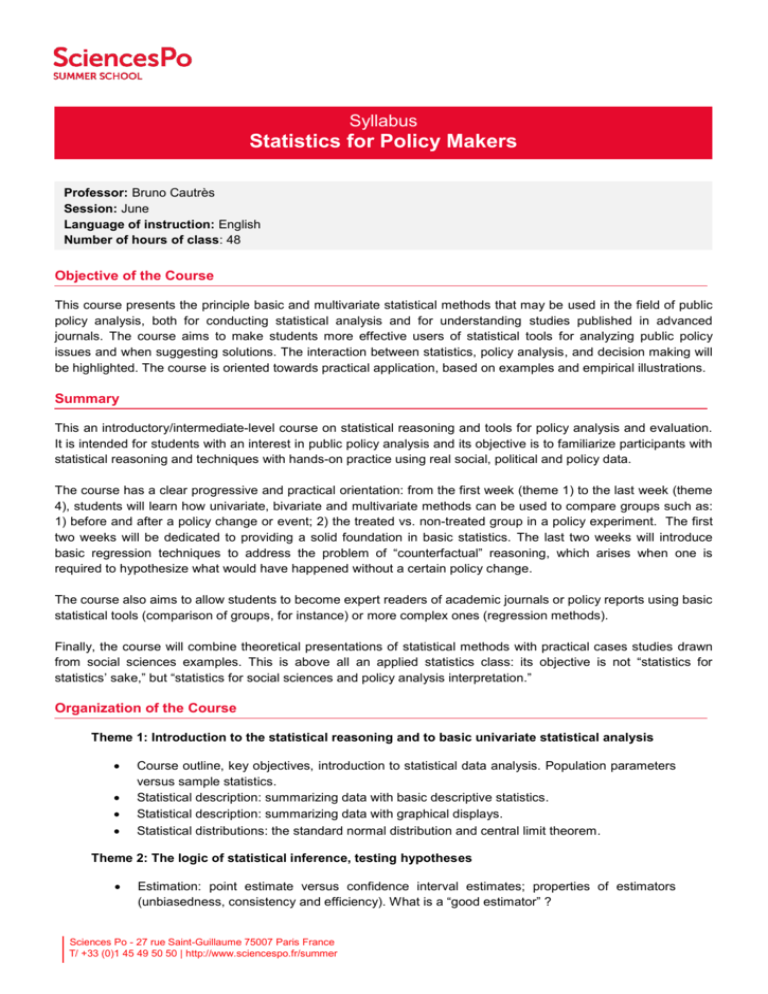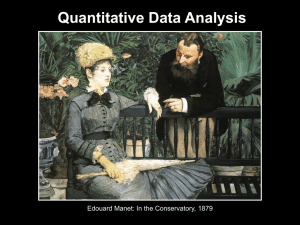
Syllabus
Statistics for Policy Makers
Professor: Bruno Cautrès
Session: June
Language of instruction: English
Number of hours of class: 48
Objective of the Course
This course presents the principle basic and multivariate statistical methods that may be used in the field of public
policy analysis, both for conducting statistical analysis and for understanding studies published in advanced
journals. The course aims to make students more effective users of statistical tools for analyzing public policy
issues and when suggesting solutions. The interaction between statistics, policy analysis, and decision making will
be highlighted. The course is oriented towards practical application, based on examples and empirical illustrations.
Summary
This an introductory/intermediate-level course on statistical reasoning and tools for policy analysis and evaluation.
It is intended for students with an interest in public policy analysis and its objective is to familiarize participants with
statistical reasoning and techniques with hands-on practice using real social, political and policy data.
The course has a clear progressive and practical orientation: from the first week (theme 1) to the last week (theme
4), students will learn how univariate, bivariate and multivariate methods can be used to compare groups such as:
1) before and after a policy change or event; 2) the treated vs. non-treated group in a policy experiment. The first
two weeks will be dedicated to providing a solid foundation in basic statistics. The last two weeks will introduce
basic regression techniques to address the problem of “counterfactual” reasoning, which arises when one is
required to hypothesize what would have happened without a certain policy change.
The course also aims to allow students to become expert readers of academic journals or policy reports using basic
statistical tools (comparison of groups, for instance) or more complex ones (regression methods).
Finally, the course will combine theoretical presentations of statistical methods with practical cases studies drawn
from social sciences examples. This is above all an applied statistics class: its objective is not “statistics for
statistics’ sake,” but “statistics for social sciences and policy analysis interpretation.”
Organization of the Course
Theme 1: Introduction to the statistical reasoning and to basic univariate statistical analysis
Course outline, key objectives, introduction to statistical data analysis. Population parameters
versus sample statistics.
Statistical description: summarizing data with basic descriptive statistics.
Statistical description: summarizing data with graphical displays.
Statistical distributions: the standard normal distribution and central limit theorem.
Theme 2: The logic of statistical inference, testing hypotheses
Estimation: point estimate versus confidence interval estimates; properties of estimators
(unbiasedness, consistency and efficiency). What is a “good estimator” ?
Sciences Po - 27 rue Saint-Guillaume 75007 Paris France
T/ +33 (0)1 45 49 50 50 | http://www.sciencespo.fr/summer
Hypothesis testing reasoning
Hypothesis testing to test for equality of means and proportions across groups
Theme 3: Bivariate statistical analysis; the different ways to study the relationships between X
and Y
Bivariate analysis : contingency tables
Bivariate analysis: covariance and correlation.
From correlation to causality: limits, dangers, interest of “causal reasoning” for policy analysis
Theme 4: Multivariate analysis; the regression technique framework and its applications to
policy analysis and evaluation
Introduction to the linear regression model: origins, basic objectives, OLS estimation, testing
hypothesis in OLS regression, how to test for the quality of a model?
Introduction to multiple linear regression analysis, the logics of “ceteris paribus” reasoning.
Making it more complex: dummy variables and interactions in the context of the before/after
causal reasoning and of the “treated/non treated” reasoning.
How regression technique can be employed in quasi-experimental research designs:
introduction to differences-in-differences regression, instrumental variables, discontinuity.
Bibliography
th
Alan Agresti, Barbara Finlay. Statistical Methods for the Social Sciences. 4 edition. Upper Saddle
River, N.J., Pearson Prentice Hall, 2009.
nd
Paul M. Kellsttedt, Guy D. Whitten, The Fundamentals of Political Science Research. 2 edition.
Cambridge, Cambridge University Press, 2013.
th
Damor Gujarati. Basic Econometrics. 4 edition. Noida, India, Tata McGraw-Hill, 2004.
Requirements for course validation
Students will be evaluated on the basis of occasional preparatory statistical exercises and the validation of a
final exam based on a practical example or case study.
Professor Biography
Dr. Bruno Cautrès is a CNRS researcher at the CEVIPOF - Centre de recherches
politiques, Sciences Po, Paris. His research focuses on voting behavior, comparative
political behavior and European electoral integration. He has been involved in the main
comparative surveys such as the International Social Survey Programme, the
European Social Survey, the European Values Studies, and the European Election
Studies. He also participates in the large scale elections studies conducted by
CEVIPOF at Sciences Po. He regularly teaches statistics and data analyses at
Sciences Po and the ECPR or IPSA methods schools. Some of his publications include
Les européens aiment-ils (toujours) l’Europe?, Paris, La Documentation Française,
2014; Bélanger, Éric, Bruno Cautrès, Michael S. Lewis-Beck, Richard Nadeau and
Martial Foucault, Le Vote des Français de Mitterrand à Sarkozy, Paris, Presses de Sciences Po, 2012; Cautrès,
Bruno and Anne Muxel, ed(s), The New Voter in Western Europe: France and Beyond. Basinstoke, Palgrave
Macmillan, 2011.
Sciences Po - 27 rue Saint-Guillaume 75007 Paris France
T/ +33 (0)1 45 49 50 50 | http://www.sciencespo.fr/summer








